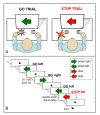Towards Conceptual Clarification of Proactive Inhibitory Control: A Review
- PMID: 36552098
- PMCID: PMC9776056
- DOI: 10.3390/brainsci12121638
Towards Conceptual Clarification of Proactive Inhibitory Control: A Review
Abstract
The aim of this selective review paper is to clarify potential confusion when referring to the term proactive inhibitory control. Illustrated by a concise overview of the literature, we propose defining reactive inhibition as the mechanism underlying stopping an action. On a stop trial, the stop signal initiates the stopping process that races against the ongoing action-related process that is triggered by the go signal. Whichever processes finishes first determines the behavioral outcome of the race. That is, stopping is either successful or unsuccessful in that trial. Conversely, we propose using the term proactive inhibition to explicitly indicate preparatory processes engaged to bias the outcome of the race between stopping and going. More specifically, these proactive processes include either pre-amping the reactive inhibition system (biasing the efficiency of the stopping process) or presetting the action system (biasing the efficiency of the go process). We believe that this distinction helps meaningful comparisons between various outcome measures of proactive inhibitory control that are reported in the literature and extends to experimental research paradigms other than the stop task.
Keywords: inhibitory control; motor inhibition; proactive inhibition; reactive inhibition.
Conflict of interest statement
The authors declare no conflict of interest.
Figures


References
-
- Logan G.D. On the ability to inhibit though and action: A user’s guide to the stop-signal paradigm. In: Dagenbach D., Carr T.H., editors. Inhibitory Processes in Attention, Memory, and Language. Academic Press; San Diego, CA, USA: 1994. pp. 189–239.
-
- Posner M.I., Cohen Y. Components of visual orienting. In: Bouma H., Bouwhuis D.G., editors. Attention and Performance X: Control of Language Processes. Erlbaum; Hillsdale, MI, USA: 1984. pp. 531–556.
-
- Logan G.D. On the ability to inhibit complex movements: A stop-signal study of typewriting. J. Exp. Psychol. Hum. Percept. Perform. 1982;8:778–792. doi: 10.1037/0096-1523.8.6.778. - DOI
-
- Logan G.D. On the ability to inhibit simple thoughts and actions: I. Stop signal studies of decision and memory. J. Exp. Psychol. Learn. Mem. Cogn. 1983;9:585–606. doi: 10.1037/0278-7393.9.4.585. - DOI
Publication types
LinkOut - more resources
Full Text Sources

